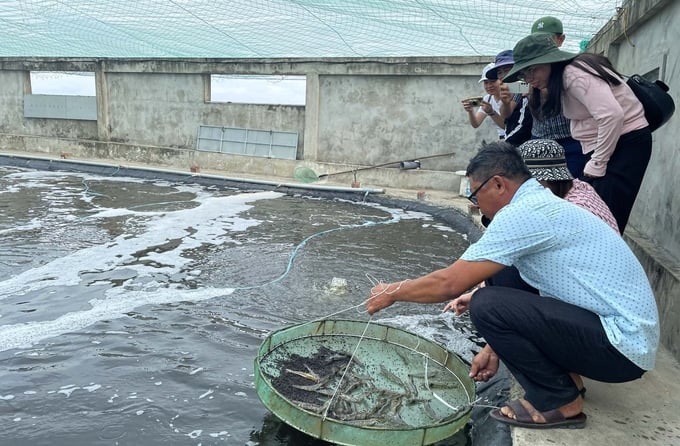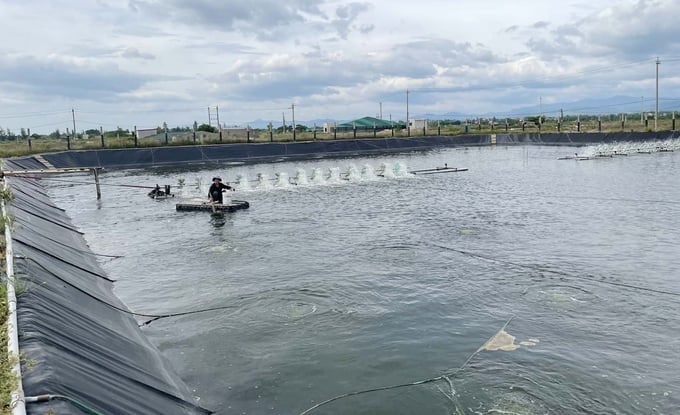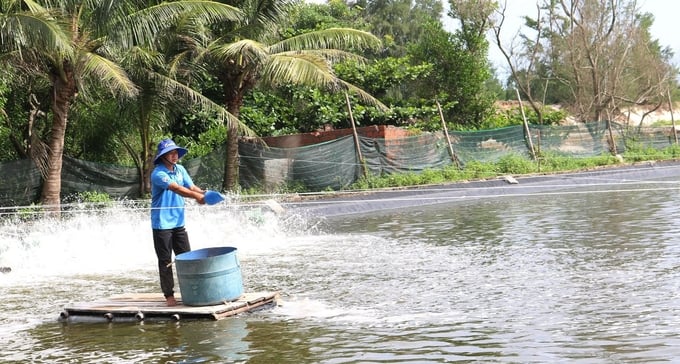May 28, 2025 | 05:15 GMT +7
May 28, 2025 | 05:15 GMT +7
Hotline: 0913.378.918
May 28, 2025 | 05:15 GMT +7
Hotline: 0913.378.918
The production of white leg shrimp has consistently accounted for a significant proportion of the total shrimp yield in Quang Binh province. Mr. Le Van Loi, Deputy Director of the Department of Agriculture and Rural Development, stated that, inspired by highly effective demonstration models from the Provincial Agricultural and Fisheries Promotion Center, shrimp farmers have expanded the cultivation area of white leg shrimp in ponds with plastic liners. This represents a new, effective, and sustainable direction for shrimp farming. Consequently, it helps farmers mitigate the impact of risks and losses during the season.
Recent complex developments in weather conditions and the deteriorating environment in shrimp farming areas have led to frequent disease outbreaks, posing challenges for shrimp farmers in Quang Binh province. Particularly, farmers have shown little concern for food safety issues and have not adopted advanced technologies in shrimp farming.

The white leg shrimp farming model in earthen ponds with plastic liners in Dong Trach commune opens up a new direction for shrimp farmers. Photo: T. Phung.
In the current shrimp farming season, the Provincial Agricultural and Fisheries Promotion Center has implemented support and investment in the model of cultivating white leg shrimp in ponds with plastic liners using advanced technology (referred to as high-tech shrimp farming) in Dong Trach commune (Bo Trach district). This initiative aims to better control the aquaculture environment, reduce the risk of disease outbreaks, cut investment costs, and enhance economic efficiency for shrimp farmers.
During our conversation, Mr. Tran Thanh Hai, Director of the Provincial Agricultural and Fisheries Promotion Center, revealed that in 2023, the center will continue to provide support and investment in the model of cultivating white leg shrimp in ponds with plastic liners using advanced technology in Dong Trach commune (Bo Trach district), covering an area of 1.2 hectares for three participating households. The application of the two-stage white leg shrimp farming process in ponds with plastic liners using advanced technology will limit the use of drugs and chemicals, a crucial condition for aiming at the development of safe and hygienic white leg shrimp products, as well as the establishment of VietGAP procedures.

Farmed shrimp exhibits excellent growth, providing farmers with a great sense of security by effectively minimizing disease outbreaks. Photo: T. Phung.
Mr. Pham Tien Dung's family in Dong Trach commune has invested in a high-tech shrimp farming model on an area of 0.7 hectares. The shrimp farming system includes fully-equipped nursery ponds, rearing ponds, water treatment ponds, wastewater ponds, and auxiliary equipment. Consequently, the system has created a cleaner farming environment, thereby reducing the risk of disease outbreaks. By dividing the farming process into two to three stages from nursery ponds to commercial ponds, Mr. Dung's family can determine the quantity and density of shrimp farming at each stage. As a result, his family has acquired effective control over the environment and feed, and reduced input costs.
In practice, high-tech white leg shrimp farming boasts a success rate of 70 to 80%, accompanied by stronger growth and higher efficiency compared to that of traditional shrimp farming. During the last shrimp crop, Mr. Dung's family stocked over 1.1 million shrimp shrimp broodstock. After harvesting, economic efficiency calculations show that the model has generated higher income for the family. Namely, the family earned over 1.8 billion Vietnamese dong from the last shrimp crop, with a profit of 600 million Vietnamese dong.
Mr. Mai Van Binh's family in Dong Trach commune was also supported with 0.3 hectares of land for high-tech white leg shrimp farming. The model is considered effective for the farming household compared to traditional shrimp farming methods, featuring advantages such as a high survival rate of shrimp broodstock, uniform commercial shrimp quality, and higher productivity.
During the farming process, the local Agricultural and Aquacultural Extension Center supported the family with 40% of the funds for buying shrimp broodstock, feed, medicine, and chemicals. After the last shrimp crop, Mr. Binh's family stocked over 480,000 certified high-quality and disease-free shrimp broodstock.

Several households have renovated their ponds to farm high-tech white leg shrimp in earthen ponds with plastic liners in Dong Trach commune. Photo: T. Phung.
According to Mr. Binh, the model helps minimize the adverse impact on the environment from the discharge process, reduce the risk of disease spread, and allow development towards safe and sustainable aquaculture. The initial application of the high-techn two-stage white leg shrimp farming model in lined ponds has changed his perspective and choice of suitable farming methods. Namely, shrimp farmers will prioritize short-term profits to move towards long-term sustainable farming. Subsequently, the farming process can be replicated to create significant opportunities for farmers to gradually increase efficiency on the same farming area. "After the harvest, the family earned around 250 million Vietnamese dong. The profit is higher, and we are also more determined in our production process," Mr. Binh shared.
According to the Quang Binh province's Department of Agriculture and Rural Development, the province has nearly 1,500 hectares of shrimp farming area in 2022. Accordingly, the province has 280 hectares of giant tiger prawn farming area, and nearly 1,200 hectares of white leg shrimp farming area. The local total shrimp yield reached 4,145 tons, with over 3,900 tons of white leg shrimp. According to the plan for 2023, the province is expected to harvest nearly 1,500 hectares of freshwater shrimp farming area, including over 1,200 hectares of white leg shrimp and 280 hectares of giant tiger prawns.
Shrimp farming is considered a key sector in the development of aquaculture in Quang Binh province. The province's agricultural sector has established high-tech concentrated shrimp farming areas within the last few years across several communes including Trung Trach, Dai Trach, Dong Trach in Bo Trach district, Hai Ninh commune in Quang Ninh district, and Ngu Thuy, Ngu Thuy Bac in Le Thuy district. In addition, there is also extensive and semi-intensive shrimp farming in Quang Tho ward in Ba Don town, Quang Xuan commune in Quang Trach district, Vo Ninh commune in Quang Ninh district, among others.
According to Mr. Le Van Loi, local shrimp farmers have proactively studied and applied scientific and technological advances in shrimp farming, such as lined pond farming, two- or three-stage shrimp farming, and high-tech shrimp farming. This effort has contributed to improving the productivity, output, and value of shrimp.

The high-tech white leg shrimp farming model in Hai Ninh commune, Quang Ninh district has shown high efficiency. Photo: T. Phung.
According to Mr. Loi, with the aim towards sustainable development in shrimp farming and aquaculture as a whole, the agricultural sector has actively disseminated information and mobilized shrimp farmers in concentrated farming areas to build cooperative and community-based models. This aims to raise farmers' awareness regarding disease prevention, environmental protection, and mutual support in the production and consumption processes.
The Department of Agriculture and Rural Development will continue to direct relevant agencies in guiding shrimp farms to apply efficient VietGAP-compliant production processes by minimizing the use of chemicals or implementing 2 or 3-stage shrimp farming. Local farmers will also be encouraged to produce along the value chain to reduce intermediary stages, production costs, and facilitate origin traceability. Consequently, the province aims to establish a sustainable shrimp farming industry, thereby providing farmers with a stable and efficient production process.
Mr. Nguyen Van The from Dong Trach commune shared that after learning from families practicing high-tech white leg shrimp farming, which is both safe and efficient, his family has decided to invest in preparing ponds for the upcoming shrimp stocking season.
"High-tech white leg shrimp farming in earthen ponds with plastic liners is suitable for the local conditions of Quang Binh province, resulting in high economic efficiency for farmers, and contributing to the development of the local shrimp farming industry as an important economic sector in sustainable aquaculture, adapting to climate change, and environmental protection. We must gradually improve the quality, value, and efficiency of local production, thereby benefiting shrimp farmers in the province," commented Mr. Le Van Loi.
Translated by Nguyen Hai Long
/2025/05/25/4127-3-073637_820.jpg)
(VAN) Thanks to the promotion from an FAO-implemented project, vegetable production in greenhouses in Moc Chau has seen strong development, from 1.5 hectares in 2021 to nearly 50 hectares in 2024.

(VAN) FAO has recently supported USD 140,000 to implement the project 'Risk mitigation human-animal interface risks through disease control initiatives in pig farming.'

(VAN) The People's Committee of Tra Vinh province has approved an adjustment to the investment policy for the Green Hydrogen Plant project, increasing its area to approximately 52.76 hectares.
![Reducing emissions from rice fields: [2] Farmers’ commitment to the soil](https://t.ex-cdn.com/nongnghiepmoitruong.vn/608w/files/news/2025/05/05/dsc08881jpg-nongnghiep-140632.jpg)
(VAN) Clean rice cultivation model in Thuong Tan commune, Bac Tan Uyen district, is assisting local residents in achieving sustainable agriculture by substantially reducing costs, increasing productivity, and protecting the environment.

(VAN) At the conference to disseminate Resolution No. 68, AgriS introduced its digital agricultural ecosystem and reaffirmed its commitment to accompanying the Government in promoting private sector development and sustainable agriculture.

(VAN) 'Blue Ocean - Blue Foods' initiative is designed to restore marine ecosystems and establish sustainable livelihoods for local communities by cultivating a minimum of 1,000 hectares of cottonii seaweed in the first three years.
/2025/05/21/4642-3-112707_603.jpg)
(VAN) The V-SCOPE project has made direct contributions to three out of six pillars of the Comprehensive Strategic Partnership between Vietnam and Australia.